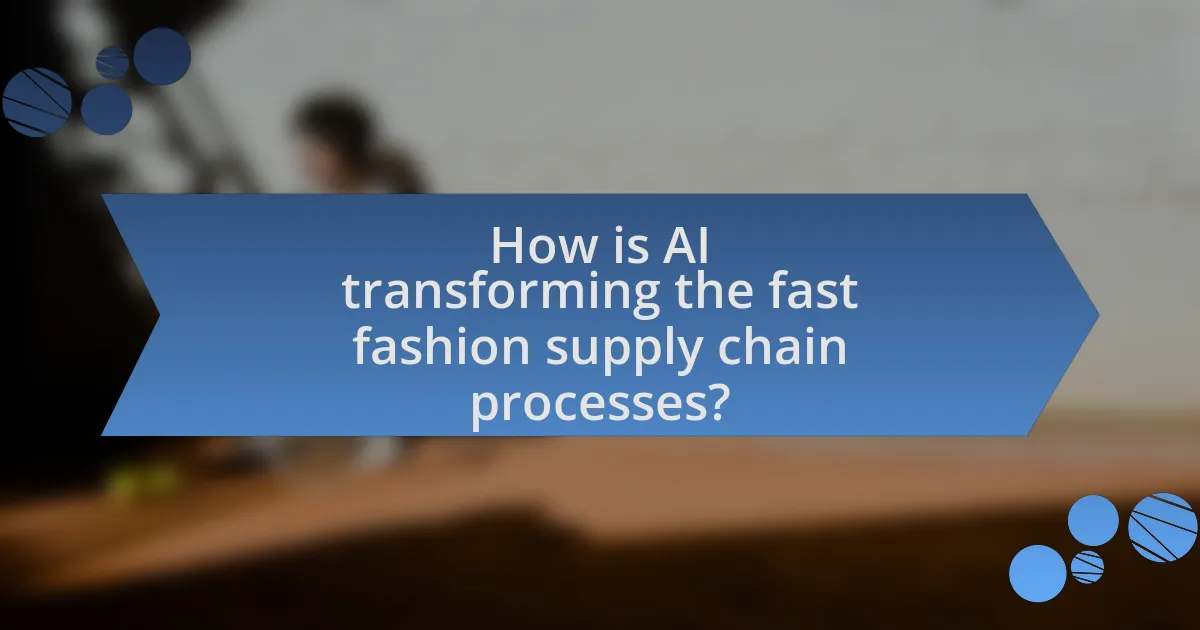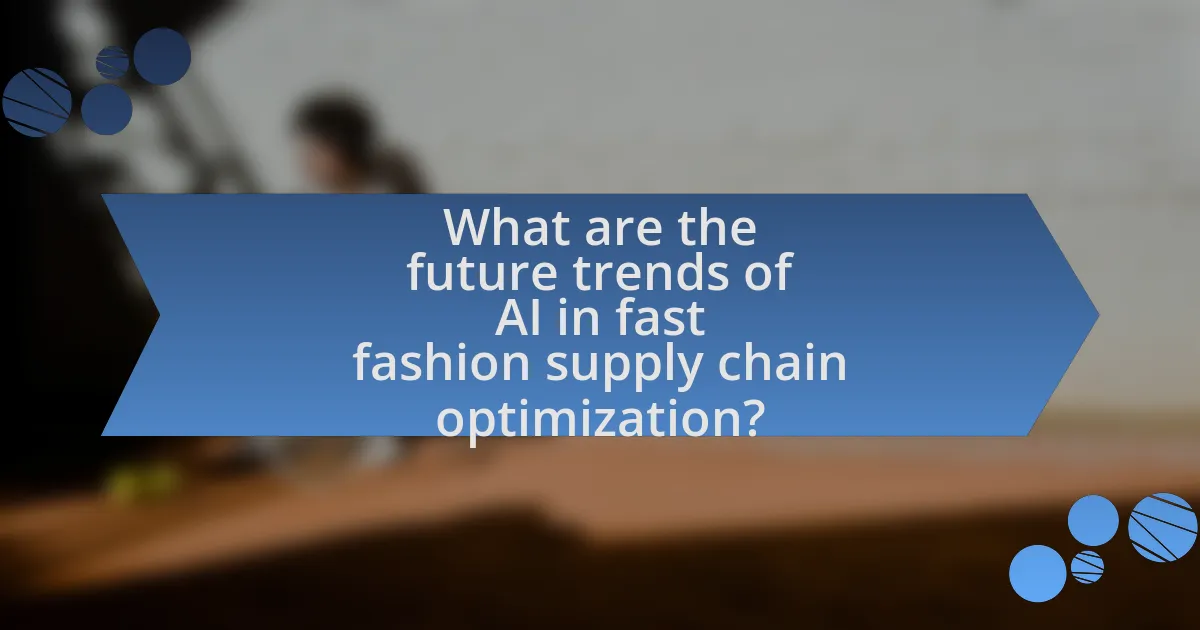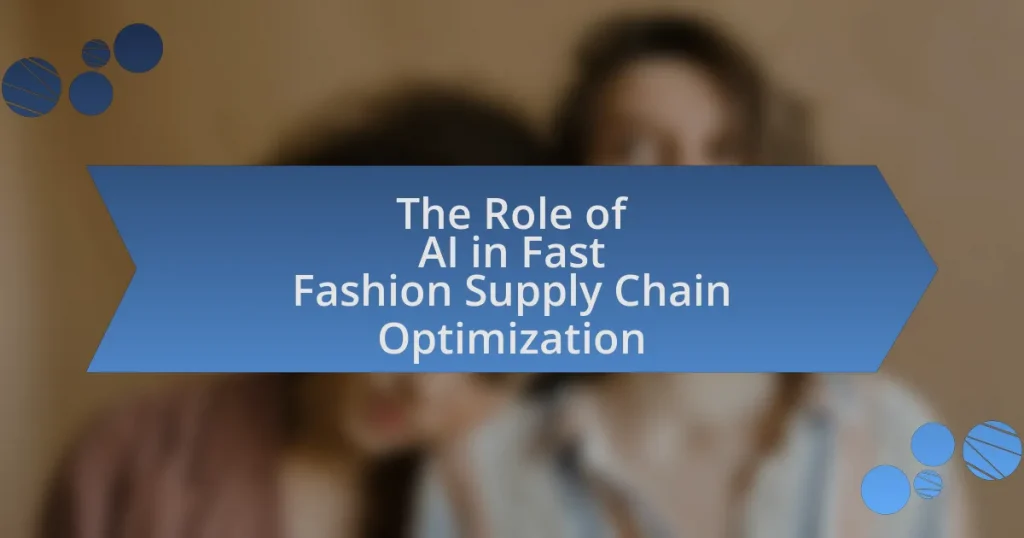The article focuses on the role of artificial intelligence (AI) in optimizing the fast fashion supply chain. It highlights how AI enhances efficiency, reduces lead times, and improves inventory management through predictive analytics and automation. Key technologies such as machine learning, natural language processing, and robotics are discussed, along with their impact on demand forecasting, production planning, and sustainability efforts. The article also addresses challenges faced by the fast fashion industry, such as overproduction and waste, and outlines best practices for successful AI integration in supply chain operations.

What is the Role of AI in Fast Fashion Supply Chain Optimization?
AI plays a crucial role in optimizing the fast fashion supply chain by enhancing efficiency, reducing lead times, and improving inventory management. Through predictive analytics, AI algorithms analyze consumer trends and demand patterns, enabling brands to make data-driven decisions that align production with market needs. For instance, a study by McKinsey & Company highlights that AI can reduce forecasting errors by up to 50%, leading to more accurate inventory levels and minimized overproduction. Additionally, AI-driven automation in logistics streamlines operations, allowing for faster response times and cost reductions. This integration of AI technologies ultimately supports the fast fashion industry’s need for agility and responsiveness in a highly competitive market.
How does AI influence the fast fashion supply chain?
AI significantly influences the fast fashion supply chain by enhancing efficiency and responsiveness. Through predictive analytics, AI enables brands to forecast trends and consumer demand accurately, allowing for quicker design and production cycles. For instance, companies like Zara utilize AI algorithms to analyze sales data and social media trends, which helps them reduce lead times from design to retail to as little as two weeks. Additionally, AI-driven automation in inventory management optimizes stock levels, minimizing overproduction and waste, which is crucial in the fast-paced fashion industry. This integration of AI not only streamlines operations but also supports sustainability efforts by reducing excess inventory and improving resource allocation.
What are the key AI technologies used in supply chain optimization?
Key AI technologies used in supply chain optimization include machine learning, predictive analytics, natural language processing, and robotics. Machine learning algorithms analyze historical data to forecast demand and optimize inventory levels, enhancing efficiency. Predictive analytics utilizes statistical techniques to anticipate future trends, allowing companies to make informed decisions. Natural language processing enables the analysis of unstructured data, such as customer feedback, to improve service and product offerings. Robotics automates warehousing and logistics processes, reducing operational costs and increasing speed. These technologies collectively enhance responsiveness and agility in supply chains, particularly in fast fashion, where trends change rapidly.
How does AI improve decision-making in fast fashion?
AI improves decision-making in fast fashion by analyzing vast amounts of data to predict trends, optimize inventory, and enhance customer personalization. For instance, AI algorithms can process sales data, social media trends, and consumer behavior patterns to forecast which styles will be popular, allowing brands to produce items that meet market demand. According to a report by McKinsey, companies that leverage AI in their supply chain can reduce forecasting errors by up to 50%, leading to more efficient inventory management and reduced waste. This data-driven approach enables fast fashion retailers to make informed decisions quickly, aligning production with consumer preferences and market dynamics.
What challenges does the fast fashion industry face that AI can address?
The fast fashion industry faces challenges such as overproduction, inventory management, and sustainability, which AI can effectively address. AI technologies can analyze consumer trends and predict demand more accurately, reducing the risk of overproduction. For instance, AI algorithms can process large datasets from social media and sales patterns to forecast which styles will be popular, allowing brands to produce only what is needed. Additionally, AI can optimize inventory management by automating stock replenishment and minimizing excess inventory, which is crucial for maintaining profitability in a rapidly changing market. Furthermore, AI can enhance sustainability efforts by identifying inefficiencies in the supply chain, enabling companies to reduce waste and improve resource allocation. These applications demonstrate how AI can significantly mitigate key challenges faced by the fast fashion industry.
How does AI help in managing inventory levels?
AI helps in managing inventory levels by utilizing predictive analytics to forecast demand accurately. This technology analyzes historical sales data, market trends, and consumer behavior to optimize stock levels, reducing both overstock and stockouts. For instance, a study by McKinsey & Company found that retailers using AI-driven inventory management can reduce excess inventory by up to 30%, significantly lowering holding costs and improving cash flow. By implementing AI, businesses can enhance their responsiveness to market changes, ensuring that inventory aligns closely with consumer demand.
What role does AI play in demand forecasting?
AI plays a crucial role in demand forecasting by analyzing vast amounts of data to predict consumer behavior and trends. This technology utilizes machine learning algorithms to identify patterns in historical sales data, seasonal trends, and external factors such as economic indicators or social media sentiment. For instance, a study by McKinsey & Company found that companies using AI for demand forecasting can improve forecast accuracy by up to 50%, leading to better inventory management and reduced stockouts. By leveraging AI, businesses in the fast fashion industry can respond more swiftly to changing consumer preferences, ultimately optimizing their supply chain operations.

How is AI transforming the fast fashion supply chain processes?
AI is transforming fast fashion supply chain processes by enhancing demand forecasting, optimizing inventory management, and streamlining production workflows. For instance, AI algorithms analyze consumer data and trends in real-time, allowing brands to predict demand more accurately and reduce overproduction, which is a significant issue in fast fashion. According to a report by McKinsey, companies utilizing AI for demand forecasting can improve accuracy by up to 50%, leading to better inventory turnover and reduced waste. Additionally, AI-driven tools facilitate automated decision-making in sourcing and logistics, enabling faster response times to market changes. This integration of AI not only increases efficiency but also supports sustainability efforts by minimizing excess inventory and waste in the fast fashion industry.
What specific processes in the supply chain are optimized by AI?
AI optimizes several specific processes in the supply chain, including demand forecasting, inventory management, production planning, and logistics optimization. For instance, AI algorithms analyze historical sales data and market trends to improve demand forecasting accuracy, which can lead to a reduction in overstock and stockouts. In inventory management, AI systems can automate stock replenishment and optimize storage space, enhancing efficiency. Additionally, AI enhances production planning by predicting delays and optimizing resource allocation, while in logistics, AI improves route planning and delivery scheduling, resulting in reduced transportation costs and improved delivery times. These optimizations contribute to a more agile and responsive supply chain, essential for the fast fashion industry.
How does AI enhance supplier selection and management?
AI enhances supplier selection and management by utilizing data analytics and machine learning algorithms to evaluate supplier performance and predict future reliability. These technologies analyze historical data, such as delivery times, quality metrics, and pricing trends, allowing companies to make informed decisions based on quantitative insights. For instance, a study by McKinsey & Company found that organizations leveraging AI in their supply chain processes can reduce procurement costs by up to 20%. By automating the evaluation process, AI also minimizes human bias, ensuring a more objective selection of suppliers. This leads to improved supplier relationships and optimized inventory management, ultimately enhancing overall supply chain efficiency in the fast fashion industry.
What impact does AI have on production planning and scheduling?
AI significantly enhances production planning and scheduling by optimizing resource allocation and improving decision-making processes. Through advanced algorithms and data analytics, AI can analyze vast amounts of data in real-time, allowing for more accurate demand forecasting and inventory management. For instance, a study by McKinsey & Company found that companies utilizing AI in their supply chain operations can reduce forecasting errors by up to 50%, leading to more efficient production schedules and reduced lead times. This capability enables businesses to respond swiftly to market changes, ultimately increasing operational efficiency and reducing costs.
How does AI contribute to sustainability in fast fashion?
AI contributes to sustainability in fast fashion by optimizing supply chain processes, reducing waste, and enhancing resource efficiency. For instance, AI algorithms analyze consumer demand patterns to predict trends, allowing brands to produce only what is needed, thereby minimizing overproduction and excess inventory. According to a report by McKinsey & Company, implementing AI in supply chain management can lead to a 20-30% reduction in waste. Additionally, AI-driven tools can improve material sourcing by identifying sustainable alternatives and optimizing logistics, further decreasing the environmental impact of production.
What are the environmental benefits of using AI in supply chains?
The environmental benefits of using AI in supply chains include reduced waste, optimized resource use, and lower carbon emissions. AI technologies enable precise demand forecasting, which minimizes overproduction and excess inventory, thereby decreasing waste. For instance, a study by McKinsey found that AI-driven demand forecasting can reduce inventory costs by 20-50%, leading to less unsold stock that would otherwise contribute to landfill waste. Additionally, AI can optimize logistics and transportation routes, resulting in fuel savings and reduced greenhouse gas emissions. Research from the World Economic Forum indicates that AI applications in supply chains can lead to a 15% reduction in carbon emissions. These efficiencies not only enhance sustainability but also contribute to the overall resilience of supply chains in the fast fashion industry.
How can AI help reduce waste in fast fashion production?
AI can help reduce waste in fast fashion production by optimizing inventory management and predicting consumer demand. By analyzing historical sales data and current trends, AI algorithms can forecast the quantity of products needed, minimizing overproduction and excess inventory. For instance, a study by McKinsey & Company found that AI-driven demand forecasting can reduce inventory costs by up to 30%. Additionally, AI can enhance design processes by using data analytics to identify popular styles, thus reducing the likelihood of unsold items. This targeted approach not only decreases waste but also aligns production with consumer preferences, leading to a more sustainable fast fashion model.

What are the future trends of AI in fast fashion supply chain optimization?
The future trends of AI in fast fashion supply chain optimization include enhanced predictive analytics, real-time inventory management, and automated design processes. Enhanced predictive analytics will enable brands to forecast demand more accurately by analyzing consumer behavior and market trends, leading to reduced overproduction and waste. Real-time inventory management systems powered by AI will optimize stock levels and reduce lead times, ensuring that products are available when and where they are needed. Automated design processes, utilizing AI algorithms, will allow for rapid prototyping and customization, aligning production closely with consumer preferences. These trends are supported by industry reports indicating that AI can reduce supply chain costs by up to 30% and improve responsiveness to market changes.
How is AI expected to evolve in the fast fashion industry?
AI is expected to evolve in the fast fashion industry by enhancing supply chain efficiency, improving demand forecasting, and personalizing customer experiences. As AI technologies advance, they will enable brands to analyze vast amounts of data in real-time, allowing for quicker adjustments to inventory and production based on consumer trends. For instance, companies like Zara and H&M are already utilizing AI algorithms to predict fashion trends and optimize stock levels, which reduces waste and increases profitability. Furthermore, AI-driven tools will facilitate personalized marketing strategies, tailoring recommendations to individual consumer preferences, thereby increasing customer engagement and sales.
What emerging technologies are likely to integrate with AI in supply chains?
Emerging technologies likely to integrate with AI in supply chains include blockchain, Internet of Things (IoT), and advanced robotics. Blockchain enhances transparency and traceability, allowing for secure transactions and data sharing among supply chain partners. IoT devices collect real-time data, enabling AI algorithms to optimize inventory management and demand forecasting. Advanced robotics automate warehousing and logistics processes, improving efficiency and reducing operational costs. These technologies collectively enhance the capabilities of AI, leading to more responsive and agile supply chains.
How will consumer behavior influence AI developments in fast fashion?
Consumer behavior will significantly influence AI developments in fast fashion by driving demand for personalized and sustainable products. As consumers increasingly seek unique styles and eco-friendly options, AI technologies will evolve to analyze purchasing patterns and preferences, enabling brands to offer tailored recommendations and optimize inventory management. For instance, a report by McKinsey & Company indicates that 66% of consumers are willing to pay more for sustainable brands, prompting fast fashion companies to leverage AI for sustainable sourcing and production processes. This shift in consumer expectations will lead to enhanced AI capabilities in predicting trends and managing supply chains efficiently, ensuring that brands remain competitive in a rapidly changing market.
What best practices should companies follow when implementing AI in their supply chains?
Companies should follow best practices such as defining clear objectives, ensuring data quality, fostering cross-functional collaboration, and continuously monitoring AI performance when implementing AI in their supply chains. Defining clear objectives helps align AI initiatives with business goals, ensuring that the technology addresses specific challenges. Ensuring data quality is crucial, as AI systems rely on accurate and relevant data to make informed decisions; for instance, a study by McKinsey found that companies with high-quality data can improve their operational efficiency by up to 20%. Fostering cross-functional collaboration encourages diverse perspectives, which can enhance AI model development and implementation. Finally, continuously monitoring AI performance allows companies to adapt and optimize their systems based on real-time feedback, leading to improved outcomes and efficiency in supply chain operations.
How can companies ensure successful AI integration in their operations?
Companies can ensure successful AI integration in their operations by establishing a clear strategy that aligns AI initiatives with business objectives. This involves identifying specific use cases where AI can enhance efficiency, such as demand forecasting or inventory management, which are critical in fast fashion supply chains. Research indicates that organizations that adopt a structured approach to AI implementation, including stakeholder engagement and continuous training, experience a 30% increase in operational efficiency (McKinsey & Company, 2021). Additionally, investing in robust data infrastructure and fostering a culture of innovation are essential for leveraging AI effectively.
What common pitfalls should be avoided when using AI in fast fashion supply chains?
Common pitfalls to avoid when using AI in fast fashion supply chains include over-reliance on data without context, inadequate integration with existing systems, and neglecting ethical considerations. Over-reliance on data can lead to misguided decisions if the data is incomplete or biased, as seen in cases where AI models failed to predict consumer trends accurately. Inadequate integration can result in siloed operations, hindering the efficiency that AI aims to enhance. Neglecting ethical considerations, such as labor practices and environmental impact, can damage brand reputation and consumer trust, as highlighted by backlash against brands that fail to address sustainability issues.















